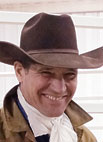 When Robert Redford needed an adviser for the movie, The Horse Whisperer, he found Curt Pate – a world-renowned stockmanship expert. When Heath Kohler from Ratcliff Ranches in Vinita, Okla., needed an adviser for low stress cow handling, he and Dr. Clint Gardner, a veterinarian in Pryor, Okla., found the “cow mumbler,” as he is known. The owner of Ratcliff Ranches, Jim Ratlciff, liked the idea and hosted the event. Heath and Dr. Gardner contacted Kara Jett of Boehringer Ingelheim Vet Medica, Inc., and Heather Buckmaster of the Oklahoma Beef Council and all together sponsored the event which discussed animal health and how to handle cattle.
When Robert Redford needed an adviser for the movie, The Horse Whisperer, he found Curt Pate – a world-renowned stockmanship expert. When Heath Kohler from Ratcliff Ranches in Vinita, Okla., needed an adviser for low stress cow handling, he and Dr. Clint Gardner, a veterinarian in Pryor, Okla., found the “cow mumbler,” as he is known. The owner of Ratcliff Ranches, Jim Ratlciff, liked the idea and hosted the event. Heath and Dr. Gardner contacted Kara Jett of Boehringer Ingelheim Vet Medica, Inc., and Heather Buckmaster of the Oklahoma Beef Council and all together sponsored the event which discussed animal health and how to handle cattle.
Curt lives in both Montana and Texas. About 5 years ago, he decided to switch from horse training to proper cattle handling. “You want to apply pressure in a way that does not stress out the animal and gets the job done. If you pressure properly, you will use less force. If you watch how cattle work, they will seem stressed and bothered. We learn from them. They are easily distracted,” said Curt. Handling animals means having a safe and workable facility, work the animals to get them to accept what is happening by getting them into a routine and allow the necessary time to do the work that is needed without hurry.
Lots of ranchers are trying to improve the relationship with their animals. “We are into animal welfare and want to promote that. Hopefully, it will keep ranchers from using other types of force,” said Curt. Putting pressure on the animal does not mean to do a panic movement which can excite the animal. It means the approach, angle and amount of pressure. “Approach is real important. Animals can think of one thing at a time, and sometimes we humans do, also. If you try to get one person to put pressure on a cow, the cow is only thinking of one thing. When they get scared, they go into survival mode. It shuts their immune system down. Then you get a distressed cow that cannot function,” said Curt.
The idea is to not let the cows feel like prey and ranchers as the predators. Human behavior effects the mental state of cattle. “If you get angry, the animals do not understand that. You are applying pressure to that animal. Going towards the animal or behind him creates unwanted pressure.” There are two terms to keep in mind while handling cattle: balance point and flight zone. “With balance point, you stand in front of the animal and find the balance point. The balance point is always changing. If you are driving a truck to round them up, you have to reposition your balance point. With flight zone, you apply enough pressure at the right time, the right angle and take the pressure off at the right time and right angle.” Curt demonstrated that walking back and forth in a straight line with the cattle off to the side, did not apply pressure. However, walking towards them creates panic. “You let them see you in both of their eyes by putting pressure on each side, then you hook them face on.”
Cattle can get in a pattern easily. One can start as a pen walker or a pen rider. Once cattle gets used to it, they are in a routine, which can switch from several hours down to almost a half an hour of herding. “Any interaction with cattle effects them down the line. Calves at 200-300 pounds are hard to settle. When they get to be about 700-800 pounds, they get too pushy. They are very hard to work with at that point. You want to start handling them at around 400-600 pounds to get them to do what you want,” advised Curt. If cattle are to be moved quickly, he suggests to try and get all heads pointed in the same direction, and no pressure is needed. “Never turn your cattle in the back. If you get the ones in the front going one way and you turn the others in the back, you are going to stop your flow.
“You have to establish trust and a relationship. It is not how fast we can do things but how good we do them. Feedlots need to be prepared to accept animals that come in that are already conditioned to do what they want. This is where it is the job of the cattle handlers to prepare cattle for movement.”
Curt ended, “The best thing you can get out of stockmanship is the quality of life. The better you are with animals, the better it gets for you.”







